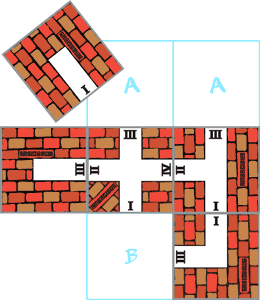Ambagibus
A Game About Mazes
Lots of people want mazes: inscrutable cultists, secretive wizards, criminal masterminds, secret services, spies, counterspies, and all manner of eccentrics. Yet not everyone has the creative genius to devise their own custom labyrinth. That's where you come in. You build tract catacombs, on a budget and in a hurry.
Ambagibus is a solitaire print-and-play card game. You play tunnel cards to construct catacombs and win if you can make it a closed system.
- Download the game [PDF]
Basic gameplay
To begin, take the top card from the deck. If it is a Bomb or Cave-in, put it at the bottom of the deck and draw again. Otherwise, place the card face up in the middle of the table.
An open passage is a tunnel opening at the edge of a card which does not lead directly into an opening on an adjacent card. Each open passage has a priority, as marked on the tunnel card: I, II, III, or IV. The object of the game is to close all of the open passages.
Draw the top card from your deck and play it so that it connects to one of the open passages, subject to two restrictions:
[#1] You cannot play so as to block an open passage. That is, you cannot make a dead end by failing to connect to an open passage. If there are no possible plays with the card you have drawn, put the card at the bottom of your deck and draw another.
[#2] You must play onto the lowest numbered open passage. For instance, you cannot play onto a IV if there is a I, II, or III open. If there are multiple open passages with the same lowest number, you may decide which to connect to.
Rule #1 takes priority over the Rule #2. For example: You may play next to a II if there is no way to play the card you drew onto any of the open I's.
Bomb cards and Cave-in cards have their own special rules.
The Bomb: You can play the Bomb on any card in the maze, regardless of priority. That space is then reopened. Passages that connected to the Bombed tunnel become open passages, and on subsequent turns you may play tunnel cards onto that space as if no tunnel had ever been there.
The Cave-in: You can play the Cave-in only on a card that have one or more open passages. After the Cave-in, all the tunnels leading in the caved-in area are considered closed. On future turns, however, you may not play cards that would direct tunnels into the Cave-in.
The basic game ends either when there are no open passages or when you have played all the cards. If you play all the cards without closing maze, total the priorities of the open passages. This is your score. Low scores are better than high scores; a closed maze means victory and has a score of zero.
An example
In the example below, the maze consists of four tunnel sections and you draw the fifth. Note that the 'I' on the card you draw does not effect placement.

The lowest numbered open tunnel is at B, so rule #2 requires you to look there first. The card you have drawn cannot go there and connect to both open passages, however, so rule #1 forbids you from placing your card there. You must put the card at either spot marked A in the diagram - your choice.
FAQ
If I have only one tunnel card on the table and draw a Bomb, does the maze count as complete? No. The Bomb makes it just as if there were no card there at all. So you have not completed a maze - you haven't even started one!
If I have only one tunnel card on the table and draw a Cave-in, does the maze count as complete? Yes. The Cave-in closes all of the open passages but leaves you with something, so it's a complete maze.
I 'win' most of my games. Am I doing something wrong? If you play by the basic rule and stop when you complete a maze, you will win more games than you lose. Try the advanced scoring rule: Set the completed maze aside and start another with the remaining deck. Try to complete as many as possible before the deck runs out.
Credits
Original design: P.D. Magnus
Playtesting: Walter Magnus, Ryan Hickerson, Cristyn Magnus, Ilya Farber, David Van Slyke, Nathan Brown, Andrew Tullsen
Ambagibus is copyright P.D. Magnus. Some rights reserved. The game is offered under a Creative Commons Attribution NonCommercial ShareAlike 3.0 License. Roughly, the Creative Commons license means that you are welcome to make use of it and to make derivative works, provided you acknowledge the original author, don't do so for profit, and share anything you make under similar terms.